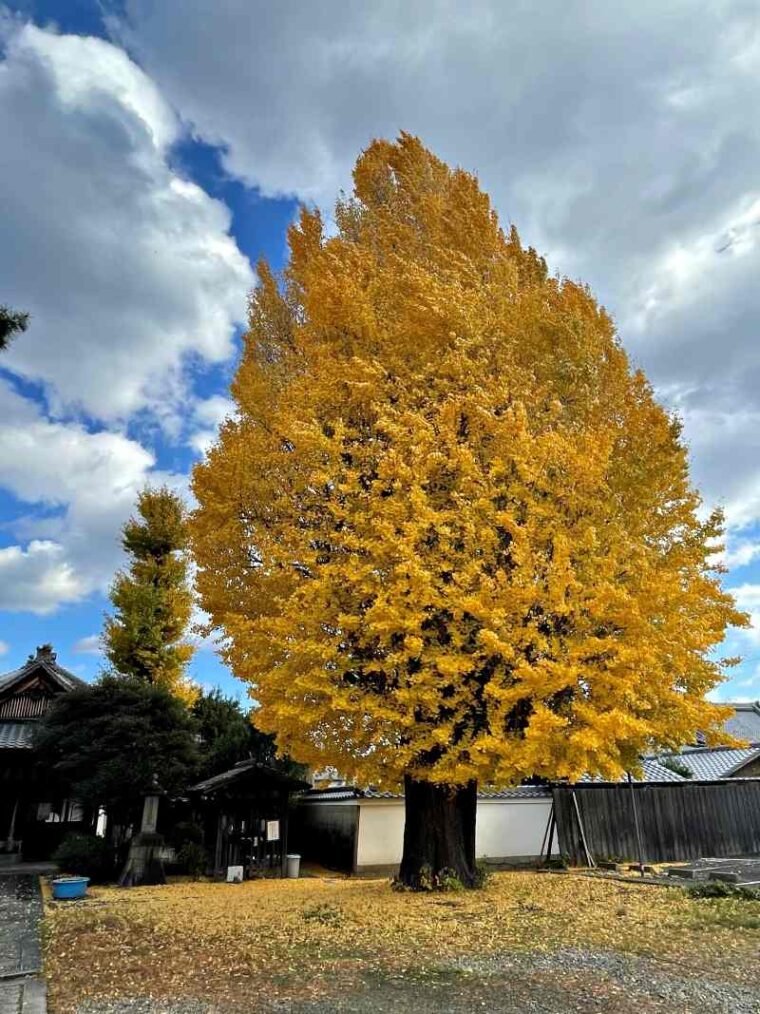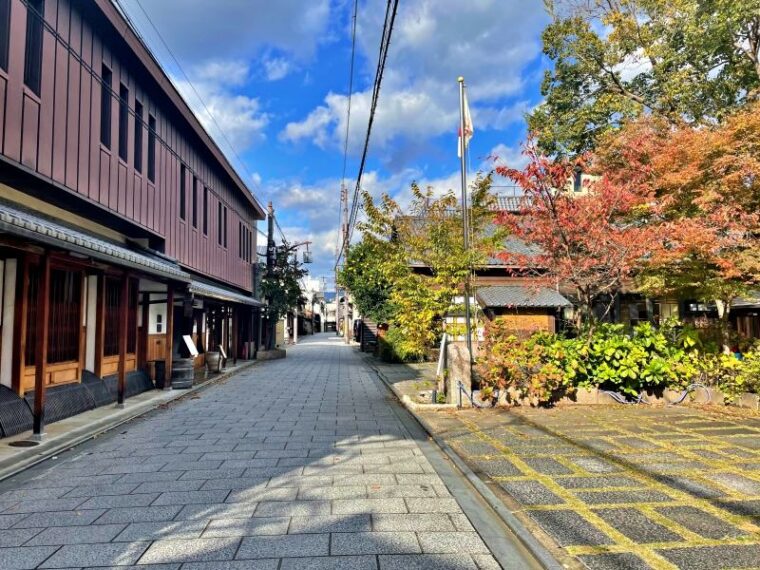Language:Japanese
On a fine afternoon, I was walking down an alley I had never been down before when I spotted a giant ginkgo tree towering high into the sky!
“In a place like this?” I wondered, and as I approached I arrived at a temple called Ekoji Temple.

Giant ginkgo tree towering over the grounds of Ekoji Temple
This area is in a corner of Nishijin, Kyoto, and there are few tall buildings, so the towering ginkgo tree in the grounds of Ekoji Temple can be seen clearly from afar.
It is a very large ginkgo tree, 15m tall (about the height of a 5-story apartment building) with a trunk diameter of 1.5m. Despite being such a large tree, all of the branches are vibrantly growing and the leaves are evenly colored in yellow, which is truly spectacular.

Ginkgo trees have male and female
Even though the leaves are turning so beautifully, the gingko nuts have not fallen at all. I wondered why, but apparently there are male and female ginkgo trees, and if you only have one of them, you can’t make ginkgo.
The ginkgo trees at Ekoji Temple are male, so it seems that they have never produced “Ginkgo nuts.”
It is said that in the past, there was a female ginkgo tree at Jofukuji Temple on the west side of Ekoji Temple, and in the spring, the ginkgo trees at Ekoji Temple release pollen, and the ginkgo trees at Jofukuji Pollinate, and in the fall, there are many ginkgo trees. It seems that the gingko nuts have been harvested.
Ekoji Temple
Ekoji Temple was founded during the Tenbun era (1532-1555) at the end of the Sengoku period, when Isa, the legal wife of Nomoto Shikibu Shosuke Teruhisa (a vassal of the 13th Ashikaga Yoshiteru), shaved her head to mourn her husband’s bodhi. It started when the mansion was converted into a temple and was called Myoho-ama. The name of the temple comes from Teruhisa’s Buddhist name “Eko.”
The main hall was destroyed by fire in 1730 (the 15th year of the Kyoho era) during the mid-Edo period, and was subsequently rebuilt.

Upon entering the Sanmon Gate, you will come across the Shichimen-do Hall, where Shichimen Daimyojin (the deity who lives in Mt. Shichimen, the sacred place of the Lotus Sutra) is enshrined.
Shichimen Daimyojin is also called “Shichimen Tennyo”, “Kichijoten”, and “Benzaiten”, and is said to have the benefit of healing eye diseases.
It is said that Ekoji Temple manufactured and sold secret eye drops up until around the Meiji period.

Access
Daikoku-cho, which resembles a typical Kyoto town
After leaving Ekoji Temple and walking north on Jofukuji Street for about 10 minutes, you will come to a cobblestone-paved road (total length: 200m, road width: average 5.5m) with a typical Kyoto scenery.
In the middle is a huge stone that is said to be the object of worship for Iwakami Shrine, which has been worshiped as the god of matchmaking, breastfeeding, and child rearing since ancient times, and is enshrined at the shrine.

At the request of the Daikoku Town “Town Development Council, Daikoku Town” turned Jofukuji Street into cobblestones in 2000 as part of its landscaping measures.
The street is lined with hand-painted Yuzen and ink painting studios, embroidery artist studios, etc. The museum “Orinasukan” run by the Hand Weaving Technology Promotion Foundation is also featured in the Japanese travel information magazine “Jalan.”
Furthermore, in the winter of 2008, JR Central used the Nishijin/Daikokucho streetscape in their campaign posters for “That’s right, let’s go to Kyoto,” as it conveyed Kyoto’s textile history and confidence.

